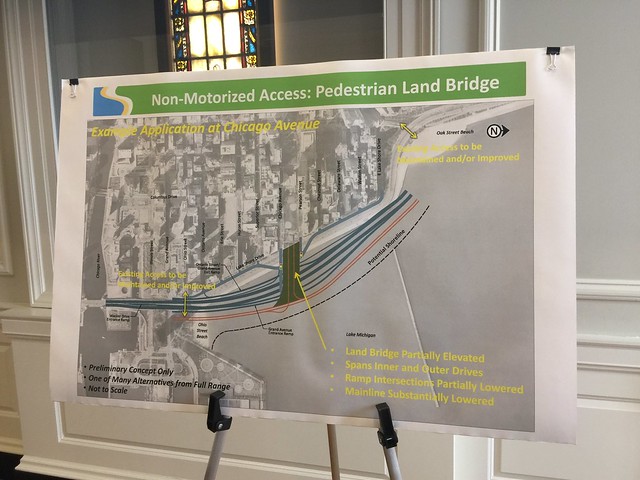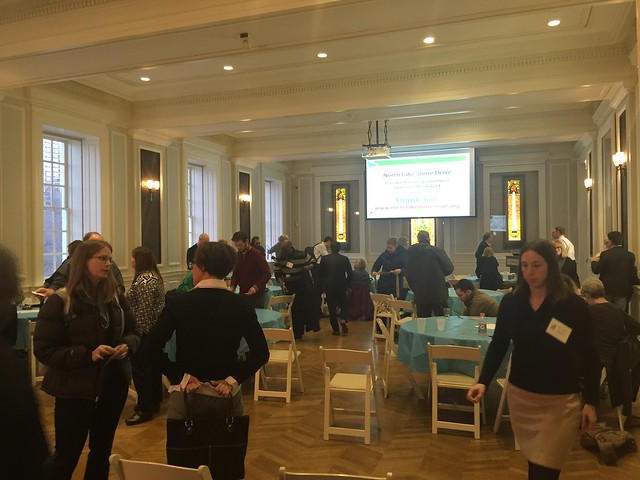
Starting in 2013, the Illinois and Chicago transportation department have hosted a series of public meetings on the North Lake Shore Drive reconstruction study, dubbed “Redefine the Drive.” At a hearing in July 2014, planners introduced Chicagoans to the project’s latest purpose and needs statement (essentially a mission statement), while also asking attendees to chime in with their own ideas for the corridor.
IDOT seems to have been busy since that last meeting, but they still haven’t presented a preliminary list of design alternatives for improving the eight-lane highway. Instead, a hearing held last week at the Chicago History Museum served as a behind-the-scenes look at IDOT’s planning process.
First, the IDOT staffers presented data gathered at the July 2014 meeting. There were 330 attendees who left 750 comments, which included 1,600 ideas. That’s a good indication that the public is paying close attention to the project, even in its early stages.
Next, the planners discussed their methods for forecasting future travel demand on the drive, using data about upcoming transportation projects from the Chicago Metropolitan Agency for Planning’s Go To 2040 plan. The region the planners are studying is a wide area, bounded by Touhy Avenue to the north, I-90/94 to the west, I-55 to the south, and Lake Michigan to the east.
The data was surprising: The population of this area was predicted to grow 15-to-20 percent between 2010 and 2040 with negligible motor vehicle traffic growth. This info provides a massive boost to arguments for prioritizing transit in the redesign of the highway.
The presenters then talked about several potential roadway junction designs. Most are so complex that grade separation for pedestrian and bike routes was highly recommended. This seems to go against the spirit of an earlier statement from IDOT that Lakeshore Drive is a “boulevard through a park and not a highway.”
On the positive side, the planner said IDOT is open to relocating or even removing some of the junctions. The Wilson Avenue interchange is probably the best candidate for removal due to its close proximity to other junctions.
Next, the presenters discussed transit on the drive, including some noteworthy statistics. The highway sees 70,000 transit trips a day on nine bus routes, accounting for about one-fifth of all passenger trips. This number is projected to grow 15-20 percent by 2040, while the number of car trips will stay flat.
To address this growth in transit ridership, the project team is looking into many alternatives including bus-on-shoulder (like some existing PACE routes), dedicated bus lanes, and even light rail. Options like these would give transit the dedicated, traffic jam-free space it needs and deserves.
Other ideas included queue jumps for buses entering and exiting the drive, as well as bus-only exit ramps located in the center of the drive. Traffic signal priority, which extends green lights and shortens reds to keep buses from getting stuck at intersections, is also being considered.
While the planners assured us that light rail is being seriously considered, the presentation focused on bus-based solutions. Cost and lack of flexibility were cited as potential drawbacks of light rail. Another potential issue with light rail that wasn’t mentioned is that it might be challenging to provide transfers between an LSD rail line and other modes.
The future of the Lakefront Trail was also a key topic of discussion, since the path is one of the most heavily used recreational routes in the country, with as many as 31,000 users a day. The project team is not only looking at reconstructing all underpasses to meet new Americans With Disabilities Act guidelines, but they want to significantly upgrade the tunnels, using more recently constructed Museum Campus underpasses as a model.
There would likely be grade separation for the pedestrian and bike routes at the junctions near Montrose Beach, where conflicts between drivers and path users are common. The planners said that complete streets guidelines will be considered when making improvement to Inner Lake Shore Drive in order to make the street work better for people on foot and bikes.
Before the halftime break there was a Q & A session. People asked about car occupancy rates on the drive (an average of about 1.2 people per car), Red Line versus LSD bus ridership, and funding transparency. Some attendees expressed concerns that walking, biking, and transit won’t be prioritized in the project. It’s hard to gauge IDOT’s commitment to these modes since the department hasn’t yet released a list of preliminary design alternatives.
The final segment covered preliminary concepts to fix the much-reviled Chicago Avenue junction. All of these alternatives except the at-grade option were very highway-like and all occupied considerable space. This is because IDOT aims to include greenspace between the inner and outer drives and add parkland between the Lakefront Trail and the highway to prevent flooding.
The planners also noted that the southern end of the project area is constrained by the Navy Pier Flyover. They showed examples of side- and center-running transit lane layouts at this location and several park and trail concepts. One of these proposed extending Lake Shore Park, located just west of the drive between Pearson Street and Chicago Avenue, east over a sunken LSD using a “land bridge”.
During the final Q & A session, attendees asked whether the Chicago Avenue junction could simply be eliminated. The planners responded that this solution would likely create more congestion at the neighboring junctions.
There were also concerns about the proposed green space between the inner and outer drive being “suburban” in nature. An IDOT rep said they would work with the Chicago Park District to create “programmable space” for events and activities.
One commenter praised the way the South Lake Shore Drive reconstruction, completed in the mid-2000s, created new access points for pedestrians and cyclists, making it easier to reach the lakefront. A presenter said IDOT plans to emulate that aspect of the South Side project. When a resident asked whether bus rapid transit stations could be constructed in the median of LSD, they were told that option is being considered.
After the meeting, IDOT staffer John Baczek told me that all design alternatives for the drive are currently still on the table and nothing has been removed from consideration. However, when the first round of alternatives is presented to the public next year, there will be a list of options that have already been eliminated.
Baczek noted that while IDOT projections show that transit use will increase, they don’t expect there will be much of a corresponding decrease in driving. Therefore, while transit-only lanes may be added to the drive, it’s unlikely this will be done by converting existing mixed-traffic lanes.
This seems like a bit of a self-fulfilling prophesy. If we continue to provide the same amount of road capacity for cars, it’s less likely that a significant amount of drivers will switch modes.
Moreover, if maintaining the same number of travel lanes makes it impossible to add dedicated transit lanes, doing so would be downright foolish, since transit ridership is expected to grow significantly. And even if it is possible to add bus lanes or light rail without converting car lanes, who really wants the eight-lane lakefront highway to get even wider?
IDOT encourages residents who are interested in “Redefine the Drive” to submit comments on the project’s website.





